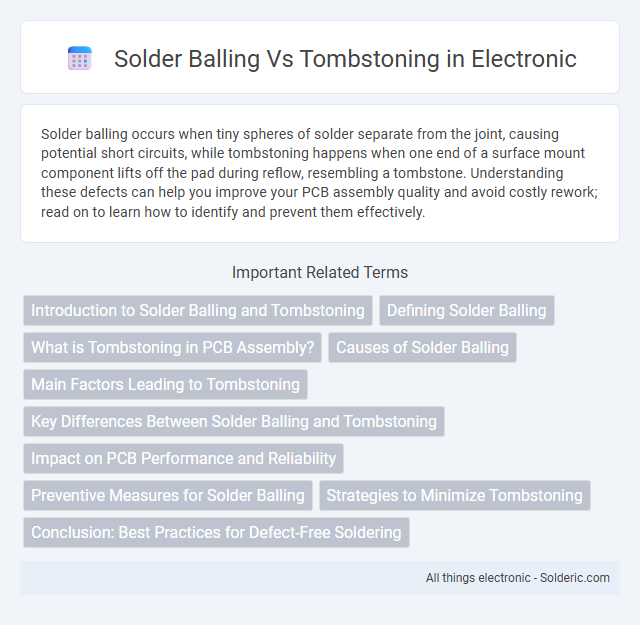Solder balling occurs when tiny spheres of solder separate from the joint, causing potential short circuits, while tombstoning happens when one end of a surface mount component lifts off the pad during reflow, resembling a tombstone. Understanding these defects can help you improve your PCB assembly quality and avoid costly rework; read on to learn how to identify and prevent them effectively.
Comparison Table
| Aspect | Solder Balling | Tombstoning |
|---|---|---|
| Definition | Formation of small solder spheres around solder joints. | Uplifting of a solder joint causing one end to lift off the pad. |
| Cause | Excess solder, flux residues, poor wetting, or contamination. | Uneven wetting forces, rapid cooling, or pad/layer imbalance. |
| Appearance | Multiple solder balls scattered around pads. | Component lifted at one end resembling a tombstone. |
| Impact on PCB | Short circuits, signal interference, or assembly failures. | Open circuit, electrical failure, or reliability issues. |
| Prevention | Optimize solder paste volume, clean PCB, control reflow profile. | Balance pad design, control heating/cooling rates, improve wetting. |
| Common Occurrence | Typically in lead-free or fine-pitch SMT soldering. | Common in small passive components like resistors, capacitors. |
Introduction to Solder Balling and Tombstoning
Solder balling occurs when tiny solder spheres form uncontrollably during the reflow process, leading to potential short circuits and reliability issues on your PCB. Tombstoning, also known as the Manhattan effect, happens when one end of a surface mount component lifts off the pad, resembling a tombstone, often caused by uneven wetting forces during soldering. Understanding these defects is crucial for improving solder joint quality and overall electronic assembly performance.
Defining Solder Balling
Solder balling refers to the formation of small, spherical solder particles on a printed circuit board during the soldering process, which can cause short circuits or component failures. It typically occurs due to excessive flux, improper solder paste application, or insufficient wetting of the solder. Understanding solder balling is crucial for improving solder joint reliability and enhancing the quality control in surface mount technology (SMT) assembly.
What is Tombstoning in PCB Assembly?
Tombstoning in PCB assembly occurs when one end of a surface-mount component lifts off the pad during solder reflow, creating a vertical, tombstone-like appearance. This defect is primarily caused by uneven wetting forces, variations in pad size, or imbalanced solder paste volume, leading to solder balling or incomplete solder joints. Identifying tombstoning is critical for ensuring reliable electrical connections and preventing circuit failures in high-density printed circuit boards.
Causes of Solder Balling
Solder balling occurs due to excessive solder paste deposition, poor flux activity, or high reflow temperatures causing solder to separate into small spheres. Contaminants on the PCB or solder mask and improper stencil design can also contribute to solder ball formation. Understanding these causes helps optimize soldering processes and reduce defects in electronic assembly.
Main Factors Leading to Tombstoning
Tombstoning occurs primarily due to uneven wetting forces between solder pads during reflow, causing one side of the component to lift and form a "tombstone" shape. Factors such as differential heating, inconsistent flux activation, and imbalanced pad sizes contribute significantly to this phenomenon. Your PCB design and solder paste application must be carefully optimized to prevent these main causes of tombstoning.
Key Differences Between Solder Balling and Tombstoning
Solder balling occurs when small, unintended spheres of solder form on a PCB during reflow soldering, often due to excessive flux or rapid heating, while tombstoning results in one end of a chip component lifting off the pad, resembling a tombstone shape caused by uneven surface tension. Key differences include the visual manifestation--solder balling appears as scattered solder spheres, whereas tombstoning is a discrete lifted component--and the root causes, with solder balling linked to solder paste composition and process parameters, and tombstoning influenced by pad design and temperature gradients. Understanding these distinctions helps you optimize reflow profiles and improve PCB assembly quality by preventing both defects effectively.
Impact on PCB Performance and Reliability
Solder balling creates tiny conductive spheres that can cause shorts and signal integrity issues, severely impacting PCB performance and reliability. Tombstoning leads to open circuits due to uneven solder wetting, resulting in intermittent failures and decreased long-term durability. Both defects compromise the electrical continuity and mechanical stability of PCBs, increasing the risk of device malfunction under operational stress.
Preventive Measures for Solder Balling
Preventive measures for solder balling include using appropriate solder paste with correct flux content and particle size to minimize excess spatter during reflow. Controlling the reflow temperature profile and ensuring proper board design, such as pad geometry and solder mask application, help reduce the risk of solder ball formation. You should also maintain clean stencil printing and regular equipment maintenance to achieve consistent solder deposition and avoid contamination.
Strategies to Minimize Tombstoning
To minimize tombstoning during PCB assembly, optimize the solder paste stencil design by ensuring consistent thickness and aperture size that promotes uniform solder volume. Control reflow oven profiles precisely to achieve balanced heating and cooling rates, reducing thermal gradients that cause uneven solder joint formation. You can also select solder alloys with appropriate melting points and surface tension properties to improve solder wetting and adhesion, effectively decreasing the risk of tombstoning defects.
Conclusion: Best Practices for Defect-Free Soldering
Minimizing solder balling and tombstoning requires precise control of reflow temperature profiles and consistent solder paste application. Implementing optimized PCB pad design alongside flux formulations that promote uniform wetting significantly reduces defect rates. Adhering to these best practices enhances joint reliability and overall soldering quality in electronic assemblies.
Solder balling vs tombstoning Infographic

 solderic.com
solderic.com